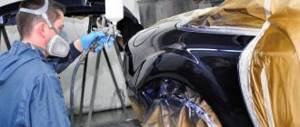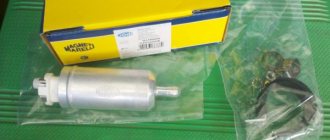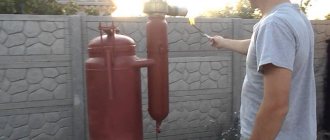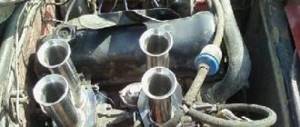Many car owners do not see a problem if there is water in the car’s gas tank. As a rule, it is present in small quantities, and therefore almost no one pays attention to this phenomenon. But, as practice shows, if there is water in the gas tank, the consequences can be unpredictable. In most cases, this contributes to the appearance of corrosion on metal surfaces. But there are often situations when, due to the presence of excess fluid, some components and devices of the power unit stop working. Therefore, you need to immediately get rid of water in the gas tank as soon as it appears, before it leads to incorrect operation.
If this is not done in a timely manner, you need to be prepared for the fact that the effects of water in the gas tank will certainly lead to contamination of the fuel supply devices in the gasoline engine. As for diesel power units, the presence of moisture in the fuel contributes to the incorrect operation of the fuel injection pump, because it damages the plunger pair. To prevent such problems, you need to know where the water in the gas tank comes from, what the symptoms of this phenomenon are and how to eliminate it.
Water in the gas tank: signs in winter
In winter, the easiest way to determine that water has entered the gas tank is by not starting the engine. This happens due to the fact that moisture freezes in the pipelines, depriving them of throughput. Consequently, fuel stops moving through the system and the engine cannot operate. In this case, the question arises not about how to remove water from the car’s gas tank, but how to start the engine. To do this, just put the car in a heated garage, and the ice will melt on its own. But this is not always possible, and therefore it is possible to forcibly heat up the pipeline. To do this, you need to turn off the fuel supply and turn the starter until gasoline comes out of the pipeline. This will be enough to start the engine and start operating the car. But do not forget that it is still necessary to expel water from the gas tank, because the ice barrier in the fuel system pipelines will repeat itself every time the car cools down.
How to remove water from a gas tank?
There are several ways to do this:
- Clean the gas tank. Drain all the gasoline from it and remove it from the car. After this, you need to pour some gasoline into the tank, close it and shake it well. Then we drain this gasoline, put the tank back and fill it with fuel as much as possible.
- In this case, you don’t have to remove the tank, although the principle is the same. You should pump out all the gasoline from there, add some fresh fuel and rock the car. Drain the gasoline again and fill the tank completely.
- You can use additives that coagulate water molecules and promote its combustion in the engine cylinders. This is convenient when there is no time or desire to specifically deal with the gas tank.
- This option has proven itself well several decades ago and is easy to use. One glass of alcohol is poured into the gas tank, which will evaporate the water well and solve the problem.
How to determine water in a gas tank in summer
As in cold weather, problems with starting the engine are also possible in summer. Therefore, information on how to get rid of water in a gas tank will also be useful in warm weather. In this case, problems with the engine arise if the fuel pump takes a lot of water from the tank and the combustible mixture cannot ignite. The second sign that the gas tank needs to be cleaned of water is when the engine starts to shake. This means that the combustible mixture ignites, but since part of the fuel has been replaced by water, a lot of oxygen remains in the exhaust gases, creating harmful compounds with other substances.
The third sign, which requires the driver to know how to remove condensation from the gas tank, also comes from the engine. If there is water in the fuel-air mixture, the car accelerates slowly, since the total power of the piston cylinders is reduced due to a shortage of gasoline. All these signs of water in the gas tank should not be ignored, even though a decrease in power and tripling of the power unit is possible for other reasons.
Why is there water in the gas tank?
Anyone who understands what will happen if water is poured into a gas tank will certainly react to the formation of moisture in the fuel supply system. If you already have experience in solving this issue, the car owner will take measures to reduce the likelihood of water appearing. Before considering the question of what to do if water gets into the gas tank, let's figure out how to reduce the likelihood of moisture appearing, understanding the main reasons for this phenomenon.
Human factor
Often, a car owner doesn’t even wonder how to remove water from a car’s gas tank until he starts adding various additives to the fuel that increase its properties, and water gets into it along with these compounds. Therefore, while improving some indicators, the car owner worsens other properties of the fuel. Also, moisture can get with it at the gas station if its composition has been deliberately changed to increase the volume. As a result, the car owner expects moisture to be removed from the gas tank.
High humidity
Another reason why many are interested in how to remove moisture from a car’s gas tank is the high humidity of the environment. Due to the excess water present in the air, it condenses inside on the walls of the fuel tank and then flows down them without mixing with the fuel. These are two different substances and, moreover, gasoline is lighter, and therefore it will be at the top, and water at the bottom. Gradually its volume will increase, and a moment will come when it will be captured by the gas pump and go into the combustion chambers. When water appears in the gas tank in this way, the symptoms will be visible in the form of drops on the lid of the fuel container.
Improper fuel storage
This applies to those people who store fuel in containers with a large amount of air, from which condensation occurs, and then, when water appears in the gas tank, what to do becomes a natural question. If storage conditions have been violated, such fuel entering the car already has a certain concentration of moisture. Unfortunately, gas stations can also neglect storage conditions. Anyone who fills up at such gas stations soon becomes interested in the question of how to remove water from the gas tank.
Temperature difference
You also have to think about how to remove moisture from a gas tank in the autumn-spring period, when day and night temperatures differ markedly. As evening approaches, the walls of the gas tank cool faster than its contents if the car spends the night outside. Due to this, when warmer air comes into contact with cold metal, condensation forms and it becomes necessary to clean the gas tank of water.
Water freezes in the car
With a sharp change in daytime temperature, even during cool nights, moisture condenses from the atmosphere and settles on metal and plastic surfaces. The gas tank is no exception. The large internal surface area allows for the release of tens of grams of water. As a result, after a couple of months of active condensation, up to a liter of water may end up in the fuel tank, which can significantly damage the vehicle’s fuel system.
Water does not dissolve in gasoline, but is mixed with it in the form of an emulsion, which, after several hours of settling, breaks up into fractions. Water accumulates in the hollows next to the fuel pump, then enters the filter and, together with the fuel, goes through the nozzles into the combustion chambers of the engine.
Article on the topic
Will the car go faster if you fill it with 98-grade gasoline instead of AI-92?
In the summer there is nothing wrong with this. Droplets of water mixed with gasoline are sprayed along with the fuel and, when burned, turn into steam, which is then removed through the exhaust system.
However, trouble can happen during the first frost.
When the temperature drops, the water freezes, blocking the fuel lines, filter and closing the fuel supply channels with an ice plug. In this case, the engine stops starting. It is impossible to clean the fuel system without warming up the entire car. It must be driven into a warm garage and wait until the warm air melts the microscopic ice crystals in the filter and inside the fuel equipment.
In the absence of a warm garage, all you have to do is leave your car parked outside and wait until the next warm spell warms up its water-logged gas tank.
Water in the gas tank: how to remove
Removing water from a tank is not a complicated procedure, but you need to know the sequence of actions. There are many ways to solve this problem, but let's look at the most effective ones. It is worth mentioning right away that it will not be possible to completely drain the water from the gas tank. However, limiting its volume is a task that can be solved by replacing fuel and constant refueling. This is one way to remove water from a gas tank without removing it, but it is expensive because you need to keep the fuel level at maximum to reduce the amount of air in the tank. Taking into account the fact that the level must be regularly monitored, this method is considered not rational, since there are more effective methods.
For example, removing water from a gas tank using special means. The principle of their action is that, interacting with water molecules, they make them even heavier. As a result, moisture settles to the bottom faster, and the fuel becomes safe for use. We looked at how to remove water from the gas tank without removing it in the previous method. Such products are sold in any automotive chemical department.
The last, most reliable method is to add special alcohol-based additives. This substance reacts with water to form a substance with approximately the same density as gasoline. Due to this, moisture does not form sediment and does not freeze. In addition, such liquid burns in combustion chambers. Thus, the use of additives designed to displace water is considered the most effective way to solve this problem.
Water in the gas tank - what to do and what are the symptoms?
Water in the gas tank can cause big problems for both the car and its owner. It would seem, how can she get there? It’s very simple, and there are various reasons for this. If this happened to you and you are looking for ways to remove water from the gas tank, we are ready to share advice. In our article, we will teach you how to remove water from a gas tank.
How can water get into the gas tank?
In principle, there is nothing complicated about this. In order not to confuse you and not overload you with information, let’s take the two most common ways how water ends up in a gas tank:
- The first method is for water to enter the tank along with the fuel. It's no secret that gasoline contains a large amount of impurities, including water;
- Water forms in the tank through a natural process called condensation. Most car owners add gasoline to the tank as needed and most of the tank is thus empty. If the tank is not full, then as a result of the temperature difference, condensation and water form on the inner walls, and then settle at the bottom of the tank, since water is heavier than gasoline.
Water in the tank causes corrosion of the gas tank, which results in the need to replace it. Water does not have the best effect on the fuel pump and injector spray nozzles; they also will not be able to work in this mode for a long time. Finally, if water gets into the fuel lines during the winter, it can simply freeze and create a blockage. The result is that you simply cannot start the car engine.
Getting into the combustion chamber, water leads to the formation of corrosion on the walls of the engine cylinder, and this is also a very serious problem.
How can you tell if there is water in the gas tank?
Symptoms of water getting into the tank will not take long to appear; the first one to react to this will be the engine. If there was a fairly significant amount of water in the tank, it would be quite difficult to start the engine. This only applies to cold starts, that is, when the engine is warmed up, it will start well, but, for example, if you start the engine in the morning, you will have to work hard.
The second symptom is uneven engine operation. Floating speed, or if the engine stalls - all this is a sign of water in the tank.
What to do if there is water in the gas tank?
There are several ways to remove water from a car tank.
- Washing the tank. It is necessary to drain the existing gasoline from the gas tank and remove the tank from the car. Then you need to pour a small amount of gasoline, close the tank cap and shake it properly. We drain the gasoline, install the tank in place and fill the fuel to capacity.
- If you don’t want to remove the tank from the car, you can simply pump out the existing gasoline from the tank, then add new gasoline in a small amount, rock the car and drain the fuel again. This is a kind of gentle washing.
- If you really don’t want to get your hands dirty, you can resort to using fuel additives that are poured directly into the gas tank. Additives coagulate water molecules and they, in turn, simply burn in the engine cylinders.
- You can also remove water from the gas tank using regular alcohol. Alcohol evaporates water very well, so you can pour a glass of alcohol into the tank to remove water. This method has been around for decades, but it still works well to this day.
How to prevent water from getting into the tank?
We advise you to always fill your car's tank full. Even if it is 2/3 full, you still need to fill it to the top to prevent the formation of condensation in the tank.
Refuel only at proven gas stations where you are completely confident in the quality of gasoline.
| The problem of battery discharge in the winter season is quite common. Therefore, knowing how to start a car if the battery is dead will be useful to every car enthusiast. After all, a dead battery is often caused by wear and tear [...] |
| When operating a vehicle, situations may arise when before changing the oil in the power unit, it is necessary to flush it. In this article we will look at how this procedure is performed using flushing oil. |
| Despite the apparent simplicity of a car battery, it requires periodic maintenance. Timely diagnostics and maintenance of the battery can extend its service life by several years and reduce the risk of violations […] |
pro-tachku.ru











